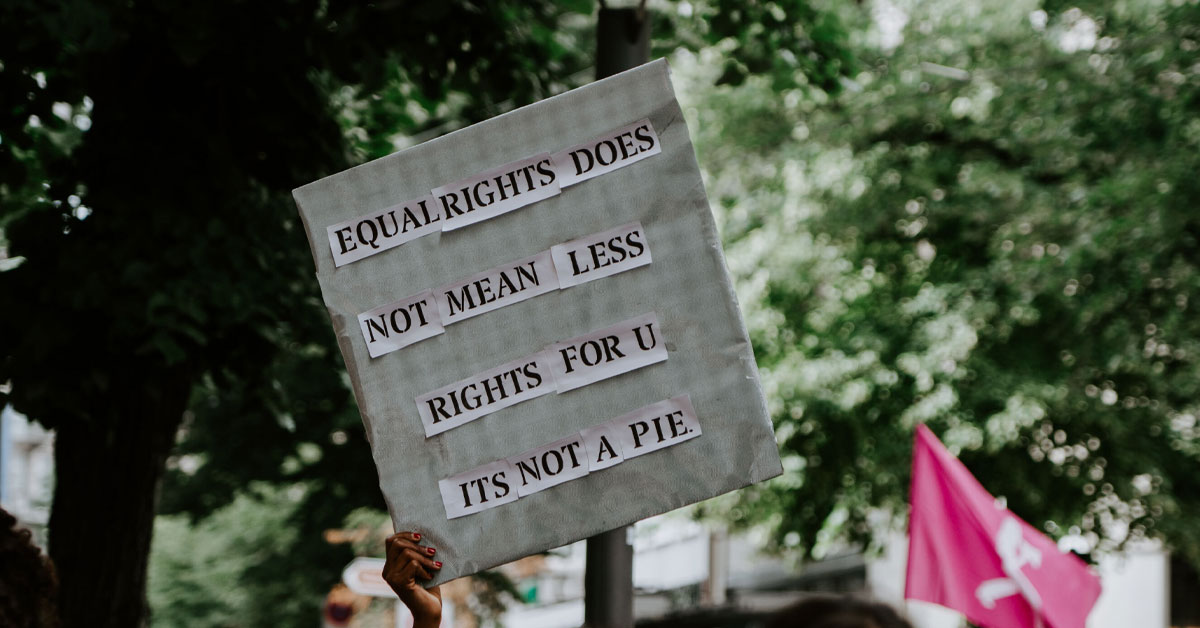Is there really a shortage of Black talent in marketing or are we simply not looking hard enough?
Brandpie is a purpose-driven business. We believe doing the right thing is good for business, people and society. And in striving to live up to our beliefs we’re always looking for ways to become more diverse and inclusive.
As the movement for racial justice has gained renewed momentum we’ve taken a look at our own organization to see how our business can better engage with, celebrate and support black talent.
Our company has diversity by gender, LBGTQ+ and ethnicity – especially from Latin and Asian communities. But when it comes to African American representation, like many in our industry, we definitely have room to grow.
So we asked Chrissie Zavicar to interview black agency owners and creatives to explore their perspectives on the challenges facing our industry.
A key question is whether there really is a shortage of Black talent in marketing and UX/UI or are we, as an industry, simply not looking hard enough?
Dana James-Mwangi, Founder of Cheers Creative, believes there is no shortage of black talent. Quite the opposite, in fact.
“I belong to social media groups made up of hundreds and thousands of black creatives from all over the world who are amazing and can go toe-to-toe with anyone in strategy, design, development, marketing, branding, PR, whatever it is,” she said.
Why, then, is the black community so underrepresented?
James-Mwangi brings up two factors.
“Black people know about a corporate game that has to be played,” she said. “There are different rules for black people in the workplace. So, even if a predominantly-white agency or company is hiring, this black person has to also consider: will this be a safe place for me? Will I be able to perform at my best here or will I be questioned at every turn like I was at my other job?”
Whether hiring a black employee or a black business to work on a campaign, it is important to look at every option equally, says Nakita Pope, Founder of Branding Chicks in Atlanta. Just because an individual or agency hasn’t worked with the biggest brands out there doesn’t mean they can’t do the job.
“It’s a matter of looking at the big picture and understanding that there is a sensibility here, there’s a specific voice that can be offered and that voice doesn’t speak for everyone,” says Nakita.
“We don’t only want to work with people that look like us. Nobody should want to. We want to work with all types of people because that makes us better and that means that we can provide a voice that they might not already have.”
Angelia Baxter, Principle UX/UI Design Consultant at The Kreativ Studio, Inc., says she has been one of a few black employees in every company she has worked with for the past 25 years, to the point that she forgets how many talented black professionals are in the industry itself.
“I can go from one room, where I am one in 3000, and everyone thinks I am a unicorn; ‘Oh my gosh, is that a black UX designer?’” Baxter says. “Then I can go to a black conference, and there’s a zillion black UX designers, and I’m thinking, ‘Where did they come from? Because these people had me convinced that I was the only black UX person on the planet.’”
Baxter recounts the experience of another woman at the TechConnect conference who said, “I’ve been here 25 years in the business. Not once have I worked with another black UX person over 25 years. Not on a contract, not full time, none of it.”
Not only do black creatives exist, it is advantageous for agencies to give them a seat at the table.
In addition to being talented regardless of race, black creatives on a marketing team bring benefits through their own life experiences and culture. When included in planning and strategy, a more diverse team can point out red flags that others may not recognize.
There have been many advertising campaigns that have attempted to depict black life and have failed because they were clearly developed without the input of anyone from the black community at the table.
“Four or five years ago when the Black Lives Matter protests first went viral, Pepsi decided to jump in the game,” said Mike Utaegbulam, Founder of Black Creative Group in Washington D.C. “It showed an ad featuring Kendall (Jenner) ending the protests with a can of Pepsi. It was so tone deaf that it might have lasted a few hours before they pulled it down… You could not have had a black voice with power in that room for that ad to make it that far.”
On the flip side are the positive campaigns that can come from black creatives taking ownership of the depiction of black life.
Burrell Communications, a predominantly-black agency founded in 1971, has done exactly that for nearly 50 years. Lewis Williams, Chief Creative Officer, remembers the success Burrell had with its first-ever client, McDonald’s.
“They were one of the first to do a television commercial with an all-black cast,” he said, “and some of the wonderful stories that we’ve told throughout the years featuring McDonald’s products have been just classic. We’ve shown wonderful stories that captured black life. If you were black, you’d go, ‘Oh yeah, that’s how I jump rope — double dutch. That’s what I sing, that’s how I talk, that’s how I look when I go to church, that’s how I eat when I leave church. We are excellent storytellers capturing black life. So we’ve done that for them for almost 50 years.”
Black creatives provide perspective across multiple cultures.
Because members of the black community are often scrutinized differently than whites, being thoughtful is part of their survival, says James-Mwangi. She discusses the importance of considering things from all sides when putting together any marketing campaign – something she recognized as a strength during a cold call she made over a decade ago when trying to get a job at an agency.
“I called a white-owned agency,” she recalled. “The lady I was speaking to looked at my work and she said, ‘Hmm, this is really good. Are you African American?’ I said, ‘Yes, I am.’ ‘That’s interesting, because it doesn’t look black.’ I didn’t really know what that meant at the time. She said, ‘You know what, you would be good for us. Because you have to be thoughtful and I don’t.’ She was just honest with me.”
“She said that if they had a client based in another country, she’d put me on it because I’d have to be sensitive to the subtleties of their culture whereas she wouldn’t. I will never forget that conversation.”
Baxter has experienced the same thing.
“We have to know how to work in the white world,” she said. “We have to understand and know how to work with other cultures — Indian, Asian, etc.. We have to know how to read all of these rooms. We have to. If you’re white, you don’t have to decide.”
If a marketing agency wants to hire for diversity, what is the best way to go about it?
“Hiring for diversity just isn’t HR’s responsibility, but is the responsibility of the organization as a whole,” reads the Association of National Advertisers (ANA) Nov. 2019 Diversity Report.
Making a point to work with recruiting/HR to source diverse candidates, attracting diverse candidates from outside the organization, intentionally recruiting from campuses with strong and diverse presence, and interviewing candidates by a diverse panel are just some of the tips cited within the report.
“I’ve had a large company reach out and say, ‘Hey, we don’t have a black agency,’ or, ‘Hey, we don’t have a black creative on the team, we would love to work with you,’” said Utaegbulam. “I appreciate that because that’s being intentional. You can’t say you can’t find any black talent because I can give you ten people in any different realm to help you out now, but I think it’s that companies are used to working with who they traditionally work with.”
In addition to hiring for diversity, it is critical to retain diverse talent. In a 2019 ANA Educational Foundation study, “The Diversity Disconnect: Charting more Inclusive Pathways to Growth,” the diversity disconnect within marketing companies was found to be exacerbated by four things:
- Management disconnection, in which new hires don’t feel their managers can relate to their experiences and don’t want to bring them up for fear of retaliation
- Microaggressions – intentional or unintentional – that leaves professionals feeling uncomfortable
- Cultural illiteracy, in which hires try not to create a problem, but also must make an effort to keep biases from being assigned to them
- Workplace integration dissonance, or a fear of bringing up diversity at the risk of losing their job.
Tiffany Ralls, an Onboarding Success Manager at Updox, struggled with a comment made within her organization on Slack regarding recent protests. She wrestled with whether she should say something or not, recognizing the repercussions that could come from speaking up.
She ultimately did, and the response from her organization was positive.
“My point was, ‘I want you to think through a different lens or a different perspective’” she said. “‘I know you see the destruction going on, but we’re destroyed as a people. Our reaction to the destruction is out of hurt. I want you to just look from another lens, try not to look down and let’s not do that in front of the whole company.’”
As a result of that conversation Tiffany was put in charge of a new Diversity and Inclusion Affinity group.
“I’ve been on the forefront just giving my opinion and really trying to get people to understand what diversity and inclusion looks like,” said Ralls. “I think these conversations, although difficult sometimes, are needed. Some people know and some people actually just don’t know. So educating people has been my No. 1 goal.”
Take the initial (or next) step.
Whether you’re a marketing agency that has already started down the path toward diversity or you are still looking to make that initial move, the key is doing it with intention and a genuine desire for change.
At Brandpie, we help businesses define their purpose, power their strategies through purpose, improve their performance through purpose and effectively communicate the purpose to the world. Making sure that the purpose accurately reflects that truth of the company’s culture is vital. Employees, clients and customers will see right through any purpose that is superficial.
The same is true of racial diversity and incorporating new talent and new ways of thinking into your business.
“If we were all the same color purple, we still would be different sizes of purple, different heights of purple,” said Williams. “I grew up where it snows with the purple people, you grew up in the sun with purple people, everybody’s going to have a different approach to summer, to winter. We’re just different people. When you add ethnicity and culture into that it just gets even richer.
“(And) every black person, people need to understand, is not going to give you the same perspective. You may have been a preacher’s daughter. I may be a kid of a single-parent family. You could be number eight out of ten. You could be the only child. You could have grown up in the south. You could have grown up in New York City.”
“You’re not coming in like the one black perspective is all I need, we’re all different. Black culture is so unique. It’s just really bringing culture in, that can be a very, very nice tool in your toolbox.”
But diversity of perspective is actually much more than simply another tool. The creative industries depend on original thinking to solve difficult challenges in new and interesting ways. If businesses like ours are to stay relevant we have to find ways to make people from all backgrounds feel that they can prosper in our agencies.
Diversity of thinking should be at the core of every creative business as it’s absolutely vital to their success.
Source: BRANDPIE




